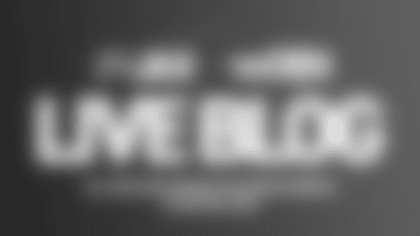For Gene Smith, not much changes philosophically.
That will be true at the NFL Scouting Combine this week and moving forward to late April, because Smith – entering his fourth season as the Jaguars' general manager – said even with a head coaching change the franchise's approach to the NFL Draft is the same:
Find the best players possible and get as many on the roster as you can.
Smith, who has final say on draft-day and personnel decisions, said he and new Head Coach Mike Mularkey have had many discussions on personnel since the latter's hiring January 11, and that they have a similar philosophy when it comes to the draft.
"Mike wants good players like I do, and your greatest need is always talent," Smith said recently.
Smith and the Jaguars' personnel officials, scouts and coaches will be in Indianapolis throughout the combine, which is scheduled to be held February 22-28 at Lucas Oil Stadium.
The Combine, since its 1982 inception in Tampa, has grown in size and profile, and its prominence on the NFL calendar has soared in recent seasons since it began being aired on the NFL Network. But it remains at its heart a week-long opportunity for NFL teams to gather medical, physical and psychological information on draft-eligible players.
Jaguars.com will be in Indianapolis Wednesday through Sunday, with Thursday through Sunday – the days players are available to the media – the primary days of coverage. On the site, we'll feature stories, news, videos and daily O-Zones. We'll also be Tweeting throughout the week.
So, as we head to Indianapolis, here's part one of jaguars.com's 2012 combine primer:
WHERE DOES THE COMBINE FIT IN THE DRAFT PROCESS?
Just about any NFL general manager – Smith very much included – will tell you the combine is just part of a huge scouting process. A big part? Yes, but still just a part.
The scouting process begins with the player's playing career, then continues with the all-star games in January. The combine will be followed by the "Pro Day" season, when college players work out on their campuses for scouts. Pro Days take up most of next month, beginning March 1 and ending with a few Pro Days in early April.
"I'm a big believer that this whole thing is a process," NFL Network draft analyst Mike Mayock said. "I don't think anybody's answering all the questions at the Senior Bowl, the combine or their Pro Day. It's all part of the process."
A key date on the national calendar this year? March 22. That's when Baylor and Stanford hold their Pro Days, and the workouts figure to be well-publicized with quarterback Andrew Luck – widely projected to be the No. 1 overall selection in the 2012 NFL Draft by the Indianapolis Colts – working out at Stanford and Heisman Trophy winning quarterback Robert Griffin III working out at Baylor.
Other key dates in the Pro Day schedule: Alabama (March 7), Southern California (March 7), Florida (March 13), Florida State (March 14), Louisiana State (March 19), South Carolina (March 28).
Justin Blackmon, the projected top receiver in the draft, will work out at Oklahoma State's Pro Day on March 7, and Quintin Coples – the projected top defensive end by many – will work out at North Carolina's Pro Day March 20.
After the Pro Days, the draft goes back behind closed doors – or, at least as much as possible these days. April is spent with teams finalizing their draft boards, and during that month, teams often will fly prospects to their facilities for final pre-draft interviews.
The draft this year will be held April 26-28 in New York and the first round will be in prime time for a third consecutive year.
HOW IMPORTANT IS THE COMBINE?
For some players, it can be very important.
That's particularly true of players with off-field incidents in their background, and for players about whom a certain physical attribute – particularly, speed – is a question.
For players with off-field issues, the interview process at the combine offers a chance to address such issues, although teams also conduct extensive background and security checks on all players.
The combine also has importance on the field.
Most general managers will tell you that whatever a player runs at the combine, the best way to analyze a player is to judge him on the game tape from college. If a guy can play, he can play. What makes the combine key is there are certain measurable – particularly speed – that a player simply can't overcome. Run a slow time at the combine, and the player is under big pressure to improve that speed at his Pro Day in March.
Run a good speed at the combine and there's often no reason to run at the Pro Day at all.
While we're on the subject of speed and the combine and measurable, the move in recent years to televise the combine has had a positive effect. While many general and managers were resistant to the NFL Network broadcasting the event, a far higher percentage of players now run and work out at the combine whereas before the event was televised many top players waited to work out at their Pro Days.
"I look at it like a former player – you get two shots at the apple if you run at the combine," Mayock said. "I'll bring up (former University of Florida cornerback) Joe Haden as an example. Joe Haden ran a poor time at the combine, went back to his Pro Day and ran a great time. He ended up being the seventh pick in the draft (by the Cleveland Browns). He didn't get dinged for the bad time he ran at the combine. People just want to see him run.
"That's what I would say to (Oklahoma State wide receiver and projected Top 10 selection Justin) Blackmon. If Blackmon comes out and runs 4.48 (at the combine), he doesn't even have to worry about running at his Pro Day. He can just concentrate on running routes and getting ready to catch the football.
"If I was playing today, and I was a position player, I would train my tail off to get ready for the 40 at the combine so I could get rid of the 40 and the cone drills. I want to get those off my plate, so I can concentrate on football for my Pro Day."
* *
WHAT ELSE MATTERS IN INDIANAPOLIS THIS WEEK?
Because Indianapolis becomes the NFL headquarters from Wednesday through Thursday, a lot goes on aside from the pre-draft interviews, medical examinations and physical testing.
Off the field, the combine is just as busy.
One reason for that is the combine isn't just the unofficial league convention for coaches, scouts and personnel officials, it's the unofficial convention for agents, too. Agents are there to assist their players through the combine, and on Friday, NFL player agents hold their annual meeting.
Because agents are there, and because general managers are, too – and because the March 13 opening of free agency is fast approaching – the combine is a place where a whole lot of negotiating between agents and GMs occurs. Under league rules, these negotiations may only involve players currently on rosters; any talk between agents and GMs about players on other teams before March 13 is considered tampering.
Still, just about everyone in the league is in downtown Indianapolis for a week less than a month from the start of the new league year. That makes the combine fertile ground for news and rumors.
And in terms of things that matter this week, remember: the combine is in Indianapolis.
That happens to be the town where the biggest story of the off-season – the future of Colts quarterback Peyton Manning – has been playing out for what seems like forever now. The deadline for the Colts to pay Manning a $28 million bonus or release him is March 8, and although reports are there won't be movement until after the combine, this story hasn't been quiet for some time. With the NFL world in Indianapolis all week, it's silly to think the combine will pass without Manning being a fairly dominant storyline.
Expect talk of all that – and a lot more – all week.
WHAT'S THE SCHEDULE THIS WEEK? WHAT HAPPENS WHEN?
The combine schedule is hectic, stuffed and a bit confusing.
The combine divides the process into position groups, and while the prospects all go through extensive medical exams, psychological testing, measuring and interviewing, the high-profile things for public/media consumption are the media access and the on-field workouts.
The schedules for those events are as follows:
*Special teams, offensive line, tight end: Media access (Thursday), on-field workouts (Friday/Saturday).
*Quarterback, wide receivers, running backs: Media access (Friday), on-field workouts (Sunday).
*Defensive line, linebackers: Media access (Saturday), on-field workouts (Monday).
*Defensive backs : Media access (Sunday), on-field workouts (Tuesday).
That means most of the news on Luck and Griffin will come the same day as the stories on Blackmon – i.e., Friday. If you're wanting to see how those guys perform – and just what they will do – then tune in to NFL Network on the day they're scheduled to work out.
So, what's the best day to tune in?
Every day will be busy, but within the scope of combine coverage, it's hard to overestimate how big Friday will be, with two potential franchise quarterbacks expected to be speaking – and with the accompanying speculation over just what will happen with Griffin, who NFL Draft analyst Mike Mayock called "one of the most gifted kids in the last several years of the draft."
"Is there some downside to Robert Griffin? Yes there is," Mayock said. "However, you probably have the opportunity to move and get him if you want him. To me, that's a pretty exciting proposition to build your young franchise around – maybe the most exciting young players in this year's draft."
Just where will RGIII end up? Just how good is Luck?
Nothing will be decided this week, but the storylines make Friday – and the rest of this week, for that matter – fascinating for draftniks and anyone else with an interest in the NFL.














